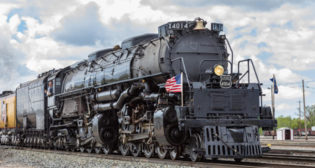
Another tunnel, another time
Written by Bruce E. Kelly, Contributing EditorAs I stated in my blog about Hunter Harrison earlier this year, the numerical “success” he was credited with during his time at Canadian Pacific would not have been possible without the hard work, tough decisions, and massive investments in property made by his predecessors.
Were it not for the nine-mile-long tunnel that CP chiseled through the Selkirk Mountains at Rogers Pass in the 1980s, as well as the re-construction of westbound ascending grades at Rogers Pass, Kicking Horse Pass, Revelstoke and Notch Hill (grades ranging from 1.6% to 2.2% being brought down to 1%), CP today would be ill-suited to face off with its chief competitor, CN, let alone serve its customers efficiently, in hauling grain, potash, coal and crude toward Pacific terminals.
It shows what can be achieved when forward thinking toward the demands of the future is matched by the will to spend appropriately in the here and now.
As a financially conservative guy, I despise seeing money (especially public money) get shoveled into certain projects when local budgets are thin, debts already hang overhead, and yet corporate raiders are sitting on mountains of cash. There may well be fiscal sensibility behind CSX’s decision to abandon its involvement in the Baltimore Howard Street Tnnel project at this time. But one has to wonder, if Harrison has already declared coal to be dead and not worth his company’s further investment, why would he back away from something that benefits intermodal at a time when intermodal is setting all-time records? Perhaps he envisions a more competitive lane for containers through some other East Coast port. Or he foresees (like many others do) an imminent downturn of the economy, which would likely kill consumer spending on imported, discretionary merchandise, at least for the near term.
At face value, CP’s Mount MacDonald Tunnel beneath Rogers Pass and CSX’s Howard Street Tunnel beneath Baltimore have little in common. One is an indispensable component in CP’s sole artery to the West Coast. The other lies on an outer belt of CSX’s complex network of main lines and branches serving the eastern third of the U.S.
Yet, the two tunnels bear witness to the management style of Hunter Harrison compared to all others. Construction of Mount MacDonald Tunnel and its associated approaches on Rogers Pass cost roughly $500 million in the 1980s, more than $987 million if built today. CSX’s share of Howard Street Tunnel is a mere $145 million. Would container business through an enlarged Howard Street Tunnel ultimately justify that investment? We may never know.
Over the past couple of months, I’ve witnessed something remarkable just a few miles from home: BNSF’s completion of yet another stage in its double-tracking of the busy Spokane (Wash.) to Sandpoint (Idaho) “Funnel,” as well as expansion of its yard leads and refueling tracks at Hauser Yard, an important servicing, staging and crew change point for BNSF’s Northwest operations. Some leaders choose to grow the business by thinning the weeds, planting more seed, and providing the necessary sustenance to get next year’s crop on its way. Others simply set fire to the whole farm, then harvest whatever is left standing among the ashes, selling it off for quick and easy profit while putting nothing back in the ground for the seasons that lie ahead.”



